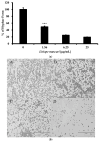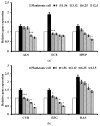Inhibition of Candida albicans Biofilm Formation and Attenuation of Its Virulence by Liriope muscari
- PMID: 38786162
- PMCID: PMC11117302
- DOI: 10.3390/antibiotics13050434
Inhibition of Candida albicans Biofilm Formation and Attenuation of Its Virulence by Liriope muscari
Abstract
(1) Background: Although Candida albicans accounts for the majority of fungal infections, therapeutic options are limited and require alternative antifungal agents with new targets; (2) Methods: A biofilm formation assay with RPMI1640 medium was performed with Liriope muscari extract. A combination antifungal assay, dimorphic transition assay, and adhesion assay were performed under the biofilm formation condition to determine the anti-biofilm formation effect. qRT-PCR analysis was accomplished to confirm changes in gene expression; (3) Results: L. muscari extract significantly reduces biofilm formation by 51.65% at 1.56 μg/mL use and therefore increases susceptibility to miconazole. L. muscari extract also inhibited the dimorphic transition of Candida; nearly 50% of the transition was inhibited when 1.56 μg/mL of the extract was treated. The extract of L. muscari inhibited the expression of genes related to hyphal development and extracellular matrix of 34.4% and 36.0%, respectively, as well as genes within the Ras1-cAMP-PKA, Cph2-Tec1, and MAP kinase signaling pathways of 25.58%, 7.1% and 15.8%, respectively, at 1.56 μg/mL of L. muscari extract treatment; (4) Conclusions: L. muscari extract significantly reduced Candida biofilm formation, which lead to induced antifungal susceptibility to miconazole. It suggests that L. muscari extract is a promising anti-biofilm candidate of Candida albicans since the biofilm formation of Candida albicans is an excellent target for candidiasis regulation.
Keywords: Candida albicans; Liriope muscari; adherence assay; antifungal agent; biofilm formation; dimorphic transition.
Conflict of interest statement
The authors declare no conflicts of interest.
Figures







Similar articles
-
Hedera rhombea inhibits the biofilm formation of Candida, thereby increases the susceptibility to antifungal agent, and reduces infection.PLoS One. 2021 Oct 6;16(10):e0258108. doi: 10.1371/journal.pone.0258108. eCollection 2021. PLoS One. 2021. PMID: 34614005 Free PMC article.
-
Adenophora triphylla var. japonica Inhibits Candida Biofilm Formation, Increases Susceptibility to Antifungal Agents and Reduces Infection.Int J Mol Sci. 2021 Nov 21;22(22):12523. doi: 10.3390/ijms222212523. Int J Mol Sci. 2021. PMID: 34830415 Free PMC article.
-
Streptococcus mutans sigX-inducing peptide inhibits the virulence of Candida albicans and oral candidiasis through the Ras1-cAMP-Efg1 pathway.Int J Antimicrob Agents. 2023 Aug;62(2):106855. doi: 10.1016/j.ijantimicag.2023.106855. Epub 2023 May 19. Int J Antimicrob Agents. 2023. PMID: 37211262
-
Inhibition of adhesion-specific genes by Solidago virgaurea extract causes loss of Candida albicans biofilm integrity.J Appl Microbiol. 2019 Jul;127(1):68-77. doi: 10.1111/jam.14289. Epub 2019 May 15. J Appl Microbiol. 2019. PMID: 31013388
-
Pullulan nanoparticles inhibit the pathogenicity of Candida albicans by regulating hypha-related gene expression.Microbiol Spectr. 2024 Nov 14;12(12):e0104824. doi: 10.1128/spectrum.01048-24. Online ahead of print. Microbiol Spectr. 2024. PMID: 39540747 Free PMC article.
References
Grants and funding
LinkOut - more resources
Full Text Sources

